Enginerding: How Are Seat Tube Angles Actually Measured & Why Does It Matter?
Words: Dan Roberts
Illustrations: Taj Mihelich
What is the seat tube angle?
Originally, the seat tube angle was one measurement along the axis of a bike's physical seat tube to the horizontal, measured in degrees. On many hardtail, road and gravel bikes this is still the case, as we have one straight tube from top to bottom.
On a side note, as a hardtail goes through its fork travel, the seat tube angle gets steeper. On a suspension bike the seat tube angle gets slacker as you go through the bike's travel. This is why hardtails can get away with seemingly slacker static angles in comparison to full suspension bikes.
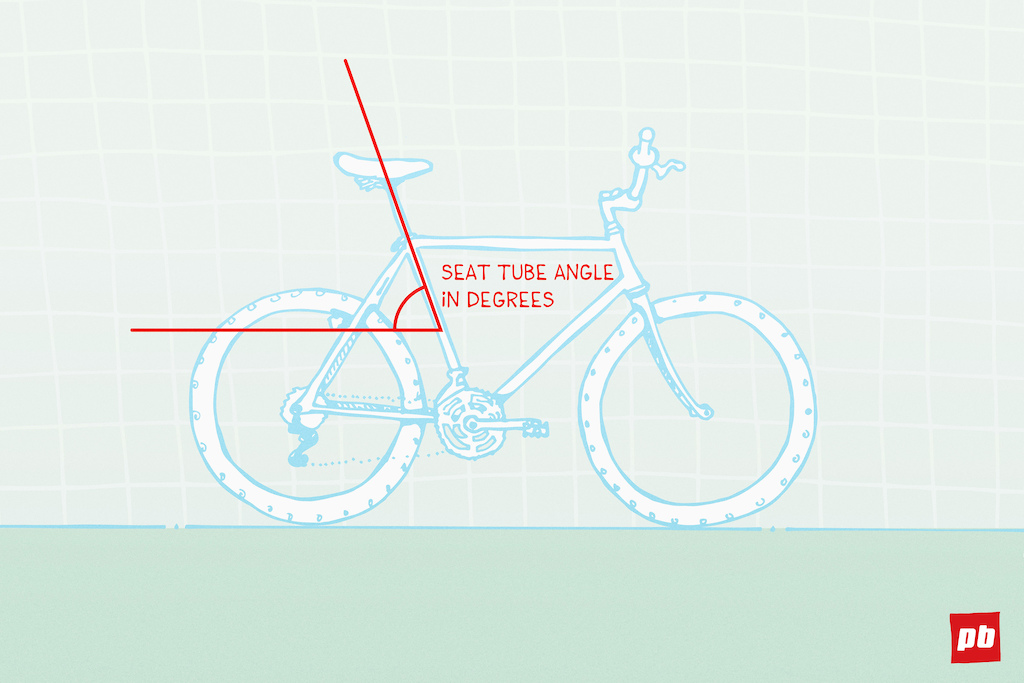
A straight seat tube, pointing directly to the center of the bottom bracket means only one seat angle. This was the case for a long time, and on some bikes it still is.
Why do we have more than one on bikes?
As full suspension bikes became more popular, we had the problem of the wheel moving around and interfering with bits of the frame. Even with small diameter wheels and small amounts of travel the wheel or seat stay bridge could come into contact with the back of the seat tube.
The physical seat tube then needed to be moved away to create some clearance for the moving wheel and frame parts. But this meant the angle of the physical, or actual, seat tube and the angle to the center of the bottom bracket, our virtual seat tube angle, weren’t the same.
Some hardtails with large wheels and short chainstays also needed the seat tube to be moved out of the way to provide enough tire and mud clearance.
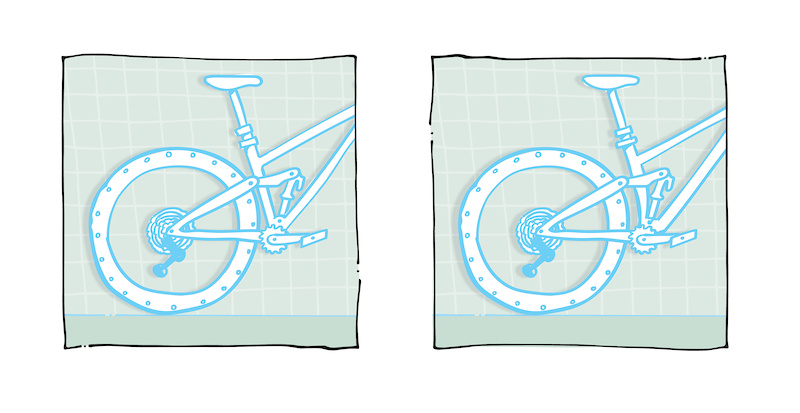
0% Loaded
1/20
With suspension travel and bigger wheels, that same straight to the BB seat tube we used to have would cause some issues. Engineers and designers had to move the physical tube out of the way to provide some clearance. And this is where we started to generate more than one seat angle and some confusion.
How do we measure the different ones?
Our current two seat tube angles are measured as follows.
The actual seat tube angle is pretty straight forward, measuring the angle to the horizontal of the actual seat tube tube.
The virtual, or sometimes called effective, seat tube angle is a little more difficult to visualise and is where our confusion and problems lie. It’s an angle measured from horizontal to the line from the center of the bottom bracket up to the intersection of the actual seat tube angle and the top of the head tube.
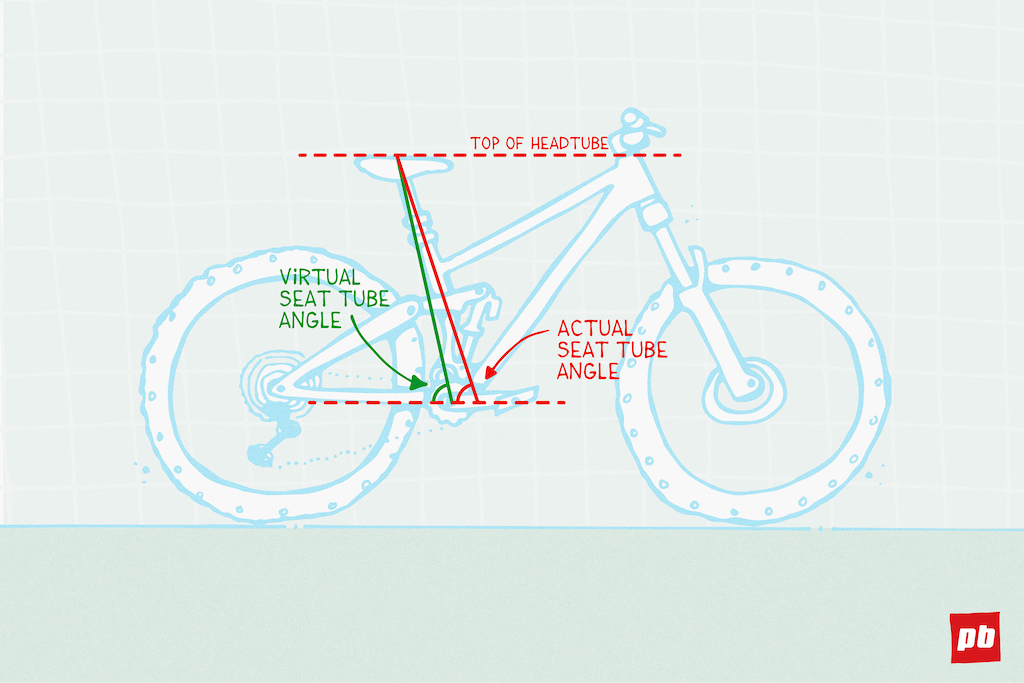
Our two seat angles, actual and virtual, are both measured from level with the top of the head tube. The actual is following the axis of our physical seat tube. The virtual points to the center of the bottom bracket. Both are measured from the horizontal.
What are the downsides to the current way of measuring?
The actual seat tube angle is a good measurement, but it only tells part of the story. The virtual seat tube angle, as it currently stands, is misleading and makes it difficult to compare bikes or even know if the one we are looking at on paper is going to fit us properly.
Most of us pedal our bike with the seat considerably higher than level with the top of the head tube. For example, I run a seat height of 820mm from the center of the BB, which is 144mm higher than the top of the Madonna V2 head tube.

We're rarely pedalling with our seat level with the top of the head tube. A more normal pedalling position is much higher, and so puts the seat further back and slackens our virtual seat tube angle in real life compared to the on-paper measurement.
The further we go above this imaginary line, the further back our seat goes and the slacker our virtual seat tube angle is in real life compared to the one on paper. Comparing bikes can also be tricky as two bikes on paper can have the same virtual seat tube angle but depending on their actual seat tube angle, and a few other factors, they can have drastically different seated positions.
The same is true of just one bike with multiple sizes. Often the virtual seat tube angle is the same for all sizes while the reality will be much different. Sometimes geometry tables only quote one seat tube angle without stating which one it is, leading to possibly more confusion.
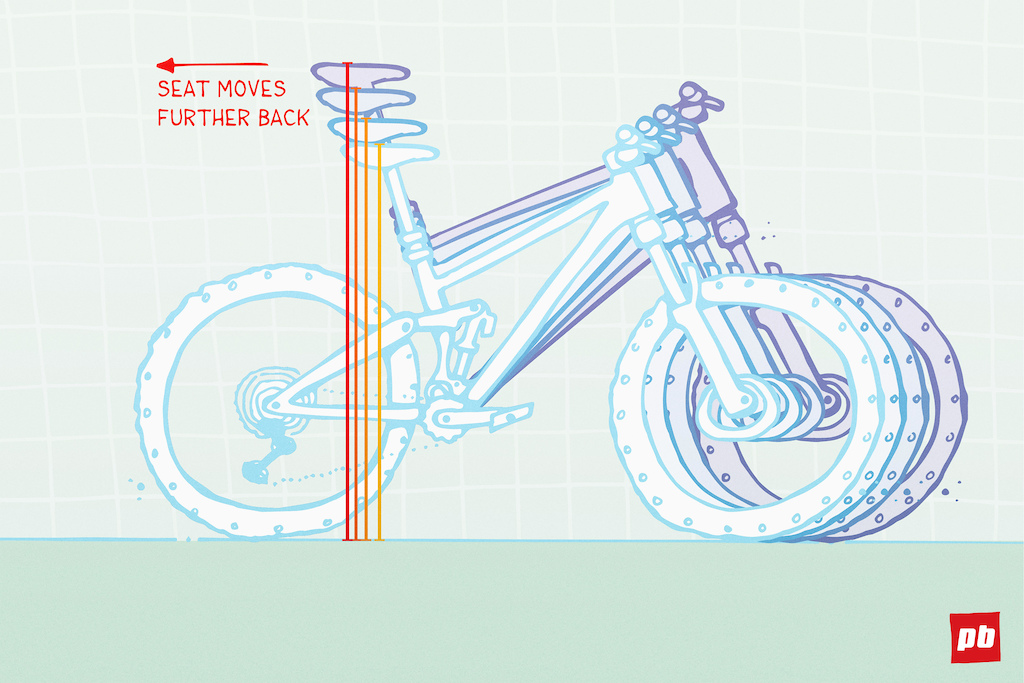
With the same seat angles, as frame sizes grow and the rider's seat height gets higher and higher, the seat moves further back and slackens the virtual angle. As the front of the bike increases in length, the rider's weight falls further back between the two contact patches. Pointing the bike up a hill then means that their weight line could fall behind the rear contact patch and cause the rider to have to work extra hard to keep the bike in check on the uphills.
What could we implement to make measuring seat tube angles better?
Our current measuring system is a bit dated. Our modern suspension bikes have evolved a lot in recent years with the increased front centers, longer reaches and increased wheel size and travel.
Some of those factors help the seat tube positioning conundrum. A longer chain stay gives more room between the wheel and seat tube, whereas the longer dropper posts, with their increased insertion, have made packaging the now shorter seat tubes into the frame trickier.
We need to add a couple more measurements into the system to help paint the full picture of where our seat will be and make it easier to understand how our bike will fit us.
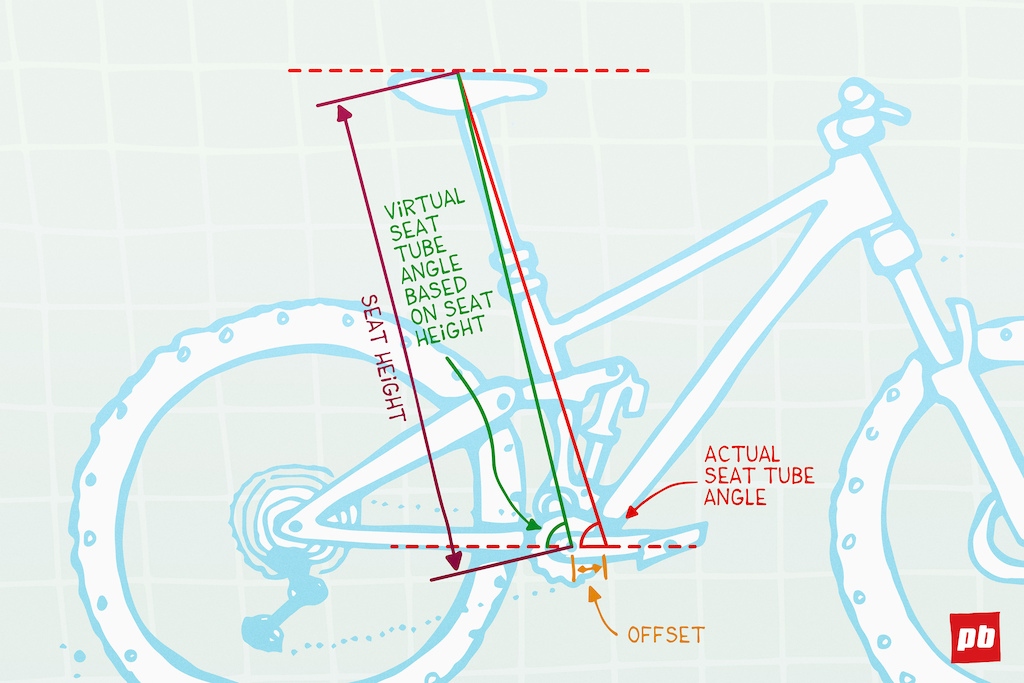
Adding in the seat height and offset from the BB to the actual seat tube angle give more information and make the virtual seat tube angle at that seat height match what we're riding in the real world.
Our actual seat tube angle is a good measurement, telling us the angle of the physical seat tube and the line along which our seat post or dropper will move.
Adding in the forward offset from the center of the BB to the actual seat tube angle gives us another side of the triangle and allows us to then calculate what our virtual seat tube angles will be for our actual seat heights. Although the trigonometry behind this is pretty involved, so there’s no easy formula to follow. Most of the time we can just draw it out in a CAD package and easily extract the angle.
There are a couple of ways of measuring this forward offset at the moment, with some using a horizontal measurement and others doing perpendicular to the seat tube.
The last, and probably most important step, is defining that seat height at which the virtual seat tube angle will be measured. The seat height is measured from the center of the BB along the virtual seat tube angle line to where it meets the actual seat tube angle line and is representative of where your seat will actually be when you’re pedalling.

Having worked with some of the tallest engineers in the industry (that's you French Dave), this stratospheric seat height isn't all that far fetched.
Is it difficult to understand?
On paper it sounds like a pain to figure this out, but some brands are already giving this information in their geometry.
Transition and Unno are two of the brands quoting the seat height at which they measure their virtual seat tube angle.
Unno currently only has one frame size available and so quote the angle for a seat height of 600mm, 650mm, 700mm and 750mm with the angle getting half a degree slacker as the seat height increases.
Transition, however, are giving out all the information. Actual seat tube angle, virtual seat tube angle, the seat height it’s measured at and also the offset from the BB. Transition use seat heights of 560mm, 600mm, 660mm, 720mm, 780mm and 820mmfor their XS, S, M, L, XL and XXL sizes respectively. Their actual seat tube angle remains the same for all sizes; as the seat height gets higher the virtual seat tube angle gets slacker.
As a rider, all you need to know is what seat height you use. And this is an easy measurement to acquire, measuring from the center of the BB to the top of the saddle.
If you want to make it more accurate then you can mask off your saddle and mark a line where the saddle is 80mm wide and use this as your reference point for getting your current setup and also replicating it on other bikes and with other saddles.
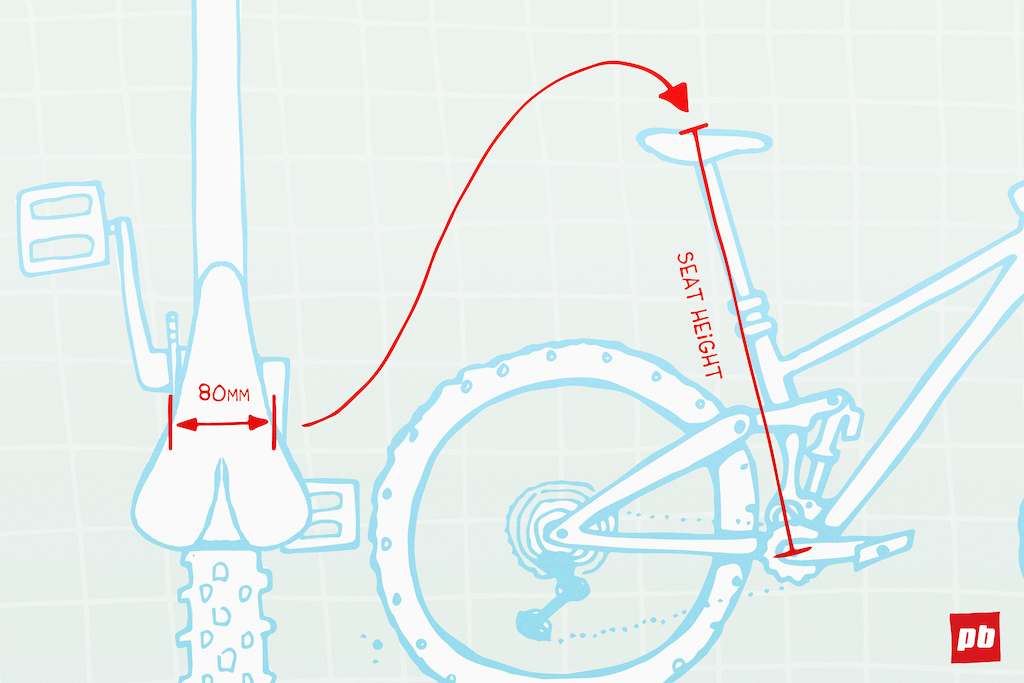
If you have your own method for measuring seat height, then you're already set. But if not, always taking the same reference point on the saddle, where it's 80mm wide, means you can then measure your height from there to the centre of the BB accurately and compare it to the geometry figures for certain bikes, or even replicate the same setup on other bikes with other saddles.
Once you know your seat height, and which size of frame you’ll be on, you can compare your seat height to that of the one stated for that size. If your seat height is higher than the one quoted then your virtual seat tube angle will be a little slacker. If your seat height is lower, then your virtual seat tube angle will be a little steeper.
If a brand is giving you all the information about offset, angles and seat heights then you can be sure that they are also designing their bikes carefully enough to have the seat in the center of the rails at the quoted measurements. This then enables you to fine tune your fit in either direction, not being backed into a corner with your adjustment. Moving your seat as little as 10mm can have the effect of over half a degree in virtual seat tube angle.
How does each measurement affect your saddle position?
Virtual seat tube angle – Simple. A slacker virtual seat tube angle puts your seat further back and a steeper one puts your saddle further forwards.
Actual seat tube angle – With all other dimensions held the same, a slacker actual seat tube angle will mean that for the same seat height the virtual seat tube angle will also be slacker, putting your seat further back.
Offset – With all other dimensions held the same, more offset will result in a steeper virtual seat tube angle putting your seat further forwards and less offset will result in a slacker virtual seat tube angle.
Saddle height – With all other dimensions held the same, if your saddle height is more than the bike's design then your virtual seat tube angle will be slacker and your seat further back. Less than the bike's design and it will be steeper and your seat further forwards.
What else is impacted by measuring seat tube angles differently?
Another measurement that is then rendered a little useless is the effective top tube measurement. This is the horizontal distance between the top of the head tube and the virtual seat tube angle.
Once again, our seats aren’t at that height when we pedal, so this measurement isn’t representative of the real world and can lead to further confusion when looking at a bike’s geometry on paper or comparing bikes.
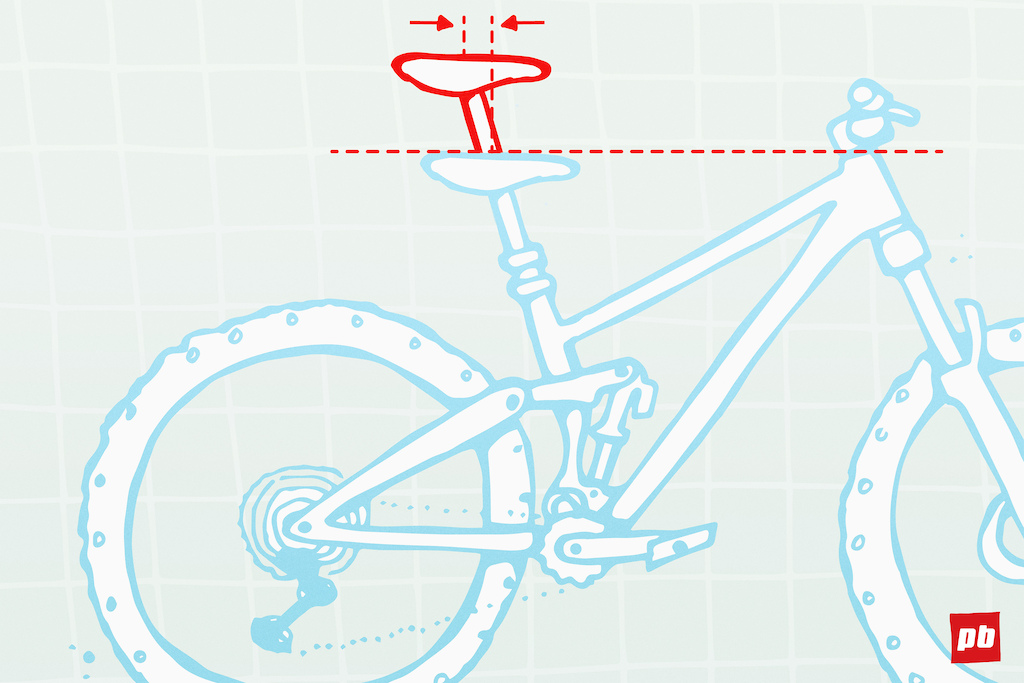
In the same way that measuring your seat tube angle level with the top of the head tube doesn't represent real life, so too is measuring the effective top tube from it. With the seat up at a real pedalling position it moves back and away from the on-paper measurement. It's also using the virtual seat tube angle measured level with the head tube, making it even less representative of real life.
If your seat is at the same height as your head tube, then you’re all good, and most downhill bikes aren’t that far off this. But the riding scenario for downhill bikes leaves no need to know or care about the effective top tube length - usually the seat position on a downhill bike is a function of clearances to the rest of the bike and the rider.
Top tubes are another topic for another day. But there also needs to be some thought into having a more meaningful measurement that better represents what we would feel on the bike. Some brands have already begun developing with the non-horizontal distance from the top center of the head tube to the stated seat height to give a more realistic measurement.
Food for thought…
Our current system of measuring seat position used to be fine before we really started to mess around with the seat tube position. But in today's world it leaves a lot to be desired. Luckily a few brands have already started a movement to give more information to accurately show where your seat will be, and that matches up far closer to reality than what we are working with now. Fingers crossed that this catches on with more brands.
As a rider and consumer, the concept of seat heights, angles and offsets isn’t super hard to grasp. And armed with your own seat height information you can then get a better idea of how you would fit on a certain bike, or extrapolate from the information given from a brand to your unique case.
If nothing else, understand that seat height affects your virtual seat tube angle and knowing at the bare minimum these two measurements is a much better way to go for brands to communicate geometry and us to understand it.
Having an industry wide set of seat heights for the various size frames would make everyone’s lives a lot easier. But getting the industry to talk, let alone agree on anything is nigh on impossible.
Hopefully this edition of Enginerding has helped shed some light on the seat tube angle conundrum. Let us know what else you'd like us to go in depth with for more Enginerding articles.
Author Info:
Must Read This Week
Sign Up for the Pinkbike Newsletter - All the Biggest, Most Interesting Stories in your Inbox
PB Newsletter Signup

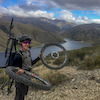
We are basically trying to get an idea of where our weight will be whilst seated. This weight is in relation to the bottom bracket and rear axle. Slack angle (which ever way you measure it) means weight over rear axle and usually poorer climbing. Steep angle and your weight is more over BB and usually better for climbing.
How about displaying where your weight falls (vertically down from top centre of seat post) as a proportion of the chain stay? Give two measurements. One for post level with top of top tube as this is a constant. One for the saddle at given distance above, and make this size specific.
A made up example could be:
Level with head tube your weight is 12% of the CS length behind the BB.
At 120mm above head tube your weight is 18% of the CS length behind the BB.
Each size frame uses a set height above head tube and make it industry standard. haha! Industry standards! haha.
100mm for small, 120mm for medium and 140mm for large frames?
This way you know how the position of the saddle, but more importantly you understand how this interacts with the rest of the frame design, most notably the CS.
OK....... I'm ready to be shot down by the engineers on here. Maybe I should stick to press ups!
I'm going to call it seat offset: ep1.pinkbike.org/p4pb19134615/p4pb19134615.jpg
IMO, its way more accurate than the guessing game that is virtual seat angle and you know exactly where your seated position is in reference to the bottom bracket. @MTB-Strength-Factory yours is a slightly more complicated version, which the manufacturers are bound to implement in different ways to suit the marketing department.
There is some science behind steeper seat angles and the benefits: www.ncbi.nlm.nih.gov/pmc/articles/PMC5786204
With that being said I do like it because once you get that dialed in you can immediately have an idea of how a bike descends compared to yours (HT angle) and how it climbs by comparing your CS percentage along with the normal reach and wheelbase of course.
A weight bias approach as you propose is a step in the right direction IMO but it would still allow significant inaccuracies in the representation of the feel a rider would have climbing.
Let's take two setups with equal seated weight bias of say 50% on level ground and a small a 150mm difference (700 vs 850mm) in inseam length. As the climb becomes steeper, the weight distribution for the taller rider will shift back at a faster pace than the shorter one since the cg swings further up from the ground. For a 25 degree slope, the difference in weight bias can be more than 5-6% which is noticeable and only gets bigger as saddle height and slope increase.
That's why you need to make STA steeper for larger bike sizes if you want to provide a more consistent climbing experience, not slacker as pretty much everyone is doing. But doing so would mean larger reach and hence WB to account for the shrunk TT length. But we all ride around the same turns, there's no point in optimizing the bike around the rider alone without thinking of the trails... haha love these articles.
This is really into the weeds though and I doubt that many companies really look into BOTH the mechanical (bike) and the bio-mechanical (ride) optimization for deciding.
Everyone with different saddle heights has their own internal definition of "steep" and "slack" and frame sizes need to start embracing different ESTAs for different size frames. Changing to a setback measurement (behind the BB, or as stated here, % of CS length) would go a long way to giving everyone (regardless of body size) similar experiences on the bike.
I think the seat position idea is a balance of the two ideas of rider fit on the bike and how the weight is distributed between the two contact patches. The latter being a bit more involved to explain with the inclusion of terrain, suspension and bike setup. Describing the rider fit seems to be a bit easier, and a good rider fit generally leads to the weight then distributed in a good way between the wheels.
I do favor few brands just cause of easy access to test ride bikes, S since they almost everywhere and Intense since they local
I get why brands would want a simple single number to compare but it is really how all these things interact that determines how the bike will feel so a more interactive option would be great. With direct to consumer brands becoming more popular it seems like this would be more important since you often can't demo those bikes.
One important thing to mention: if you have a very high or low saddle height for a given frame size (everyone is usually within 50-60mm of the average, according to our data), the ESTA does not change very much! A rider with a high saddle height on a large frame (could maybe ride an XL frame) will have an ESTA only 0.2 degrees different from the average rider's ESTA. So on a size L Mojo 4 (ESTA for average saddle height of 755mm = 76.6 degrees) the entire range of riders will have ESTAs +/- 0.2 degrees (76.4 degrees for saddle height of 815mm, 76.8 degrees for saddle height of 710mm).
My point is: ESTA, when measured at a realistic saddle height (not the top of the HT) varies very little with saddle height and you can rest assured that you are getting the geo as designed.
It wouldn't be an issue if the sites like this one weren't industry peddlers and exaggerated the benefits of certain geometry changes. Likewise, all new stuff seems to be great and flaws are only mentioned when there's a new replacement released.
There's no ideal tried and true mtb geometry like you have on the road because the terrain isn't pure tarmac and some ride big mountains with steep gradients and others ride undulating terrain.
Dropper
1xDrivetrain
Tire design
Pressure relief Saddle shaping
It's a tough call though, there's a few others vying for a spot because you're right, most of these changes (with some notable exceptions) happen gradually and add up to massive improvements over time.
Then you've got a proper sum of improvements.
I'm quite happy with my 2016 specy enduro 29 but,out of curiosity, i've just rented a 2020 mondraker crafty.
Yes, one is a moped and the other not, but geometry improvements were quite notable.
That said, the new bikes are far superior to those of even a few years ago based on my experience. The question is, what is compounding faster.... performance or pricing?
Improvements:
1. Bike Geometry/Fit/Frame design/Suspension. Longer top tube/reach numbers with wider bars and shorter stems leading to more capable/versatile bikes with less travel. Also, the industry has seemed to settle on the underlying engineering to make bikes actually work and be durable (looking at you AMP Research & ProFlex).
2. Droppers. The prolonging of the ability to continue to ride the terrain you like to ride as you age.
3. Wheel design. Wider rims, Wider tires, hub engagement, proliferation of carbon hoops. Ride wheels from the 90's and early 2000's...gigantic improvement.
4. 1x drivetrains. simplicity. weight. setup.
Unfortunately there is some collateral damage from all these. Bottom bracket standards, hub spacing standards, frames with geometries that are "out-of-date" after 2 years.
1.Geometry
2.Geometry
3.Geometry
4.Geometry
Geometry
Suspension design
Forks/shocks
Tires
Droppers
Would be my top 5. I'd rather ride a bike with those changes and the rest of the stuff from 10 years ago (spacings/standards/1X/wheels size, etc.)
Now ive gone to 29er, and sitting behind the bars is a fantastic improvement. Who do i sue for all the years ive spent on an XXL bike designed by and for someone who was 5ft nuffin?
First, there's no point in looking at the EVO as it would just become uncomfortable for me (as there's no XXL). Second, while everyone notes that XC bikes are long and stretched...being 6'4" with long arms and legs, I will still have a good bit of drop, but not so much as to be ridiculous. Finally, I have about 35# on Levy. While a 23# (if they made an XXL...I'm calling it 23#) would be nice, I don't know how much that 2-3# matters as much when you weigh 195-200.
People bemoan the tall stack (LaDuke) and I get it. Some people bemoan the steep STA b/c their wrists. But when your setup looks something like that giraffe's, the "new" geo is a game changer...or I'm just justifying getting a Spur.
I too have and continue to struggle to find bikes that fit me, and I'm just 6'3" (but with very long legs and arms). Same argument: too short of seat tube and too short of head tube. Reach has sure improved though, but it's not everything.
Trek Fuel EX in XXL comes to mind. Anything else?
If you look at the Oiz and Mondraker athletes most of them have the saddles slammed as far back as they can go to overcome the steep STA.
I would avoid the Epic just because of the Brain suspension, that alone is worth avoiding that bike IMO.
Personally I don't think I would get the fuel EX because I would have a oneup 210mm exactly bottomed out on a frame with a 540mm ST.
I used to ride bikes with much longer ETTs but it sounds like you might have a shorter torso like me and personally I've found that I like a shorter ETT but long legs and arms dictate that I'm a bit cramped with a shorter reach.
When I read reviewers saying "I wish the STA was steeper.", I have to assume that they are saying this because they already have their saddle slammed as far forward as possible. More often than not, this is reported from people who are trying to upsize to a bike with longer reach (example: someone who is 5'10", trying to ride a bike with 490mm reach numbers).
So long as your frame design and saddle rail lengths allow you to move your final seated position to optimize how your legs apply pedal throughout the power stroke, there is really nothing else to fix. This is why seat tube angles in road biking are stuck at 73-74 degrees (+/- depending on sizes) for race bikes. There is no more innovation to be had once the pedal position is optimized to your body - and pedaling positions and fit are fairly well vetted and decided upon at this point in cycling.
Vital is great but it doesnt consider the influence of suspension on the seat angle, you would have to provide a whole table of sag v inside leg length. but at the power position of a stroke the crank arm length and foot position comes in to play too for the "real angle".
Probably better to just leave it at 2 sizes, neither of which are any good with modern bikes and leave the punter quoting numbers like stack and reach of every bike even though setup plays such a big roll in both too.
I even remember running a layback post backwards way back in the day to steepen the seat angle of a bike, the clamp only just worked to get saddle angle, but it steepened my VPfree for XC days as I only had 1 bike to ride everything and only changed a few bits between rides. (wheels, shock, post)
I used this when I got my new FS frame to compare to my HT frame. Despite a 75mm difference in reach the butt to bar is within 10mm. FS bike as progressive geo, HT is a little dated but has a comfortable pedalling position. The upside was the CS were within 1mm of each other so I knew the new bike would go up hill better as it has a steep ESTA.
Also larger bikes need to have steeper ESTA and longer CS to keep the F/R balance the same and keep the seated weigh in the same location relative to the centre of the rear wheel as a smaller bike. Taj's drawing showing the different bike sizes shows this really well.
All that said there is nothing quite like demo-ing the bike you are looking to buy to get a proper feel.
As far as balance point and getting weight shifted around, chainstay and wheelbase will determine that if I position my saddle in relation to the BB.
As long as I can get my saddle in the correct position in relation to your BB I don't care where my seatpost is. Than the angle of the tube only affects where my seat will end up in the low position (or mid). If it's going to be a bit further forwards or backwards when you lower the seatpost. Personally I don't care where it ends up (down). If it's 10mm for or aft. For adjusting the top possition of your saddle - if your seat rails don't have enough length for your ideal fit, there are different offset seatposts.
The only real benefit I can see it that steeper STAs put less pressure on the telescopic seatpost internals.
What should be more discussed is ideal bike fit and especialy ideal bike fit for MTBs where you spend much more time in steep climbs than on the road which is the basis of bike fitting. And steep climbs completly change your bike geometry in terms of fit.
When I look at bike GEO for fit, I look at reach and stack and figure out what post offset/height and stem length I like based on my current rig.
The STA just tells me if I need an offset post or not. Maybe it’s important because 90% bikes come with Fox Transfer which doesn’t offer an offset (why I sold mine and picked up a 9.
Thats why STAs on their own are not impotant. OK...if you have weired fit, STA might give you some idea if the bike is going to work for you in saddle hights the frame was not designed for. I suppose that's less than 10% of riders.
...And thats also why we should be thinking more about climbing fit vs level fit and not a few degrees of STA here and there. A few companies have been trying to address thiss. For instance the Shapeshifter bike, or Specialized with the tilting telescopic seatpost. And also all the travel adjustable forks.
What? Does this "suspension bike" not have a fork? On my bike, 150F/144R, the seat tube angle (actual and effective [virtual is not the right word]) is within a tenth of a degree at full (fork and shock) squish. On bikes with an even more pronounced "reverse mullet" (longer in front) travel numbers (we've seen bikes with around 20mm difference), the seat tube may actually get steeper at full squish.
One could even argue that the sag is beneficial in that the center of gravity of the bike/rider system gets lowered, thus negating some of the rearward weight shift.
Obviously some frame & rider combos will end up with a really slack effective STA, enough that the needed chest drop will become "too much", and that sucks. But for most people, anything modernish (mid seventies effective) is a pretty good compromise between helpful on climbs and still comfortable on even terrain (where many people dislike having the pedals so far under their hips. There is a reason only TT riders use TT positioning: it sucks to pedal like that unless you're trying for max aero and/or using different muscles than running)
What we need are ETT - Effective Top Tube, and the actual seat tube angle (you'll probably have to go to your LBS and put your angle-finding smartphone app against the post to figure this out because most manufacturers won't list it for fear of getting called out on their BS "ESTA" numbers.) Once you know the actual angle and the ETT, you can get a pretty good feel for how it's going to feel under your butt. You can also get a good laugh at just how BS those ESTA numbers are - 10 degrees or more isn't uncommon.
If you prefer a low-tech approach to this, grab a string and some kind of small weight and drop a plumb-bob off the nose of the saddle on a bike that pedals well. You'll probably find that the string/weight falls 30-80mm behind the center of the bottom bracket. Much more than that and it won't pedal up steeps very nicely.
That said, I do prefer the more forward position of modern bikes, however you choose to measure it.
Definitely an ugly formula, but a pretty simple spreadsheet. Publishing for anyone who wants to use it:
docs.google.com/spreadsheets/d/1X0nk1vcS2gd268cD4K4GGA4Nf5GDsQ9hLhSex1beN-k/edit?usp=sharing
While we're at it, shouldn't we also talk about how reach is measured from the top of the headtube, but does not take into account the length of the headtube.
So a bike that has a reach of say 450mm and a head tube of 130mm at 65 deg HA is actually longer than a bike with a 460mm reach and a head tube of 100mm (all else equal).
And don't get me started on the whole short stem and riserbars issue...
Assuming you want to have the same stack height on both bikes you would need to add 30mm of spacers on the bike with the shorter headtube, which in turn makes for a shorter reach for the same possition of the stem in relation to the frontwheel
Also do you mean that a bike with a 100 mm head tube has a 30mm lower stack than one with a 130mm stack.
If this is the case the bike with the lower stack will feel like a way longer bike as the bars are further away from your shoulders.
In your example above the bike with 450 reach and 130 head tube (with all else equal) will be longer from BB to top of top tube but top tube will be shorter to shoulder so the bike with 460 reach and 100 head tube will feel a lot longer.
In my example I'm comparing two otherwise similar bikes. If I was considering both bikes one would have to assume that I want the same stack height regardless of which bike I'm buying.
Therefore the stack height including spacers will be the same for both bikes once the 30mm spacer is added to the bike with the shorter head tube.
The logical thing in order to have a measurement that can translate between bikes would be to measure reach and stack at the position of the crown race of the fork
(BTW, did you down vote my comment because you didn't agree? ????)
It is not logical to measure stack height to the crown race as that is not where your handle bars are bolted on unless you're one of those gravel bike riders. If you used this scenario you would then need to add the length of the head tube and take in to account the head angle to try and work out where your bars are going to be in relation to everything else.
No I didn't down vote you. Not my thing!
I'm glad we agree on the mathematics
When it comes to the stack height I think the same goes there, it more comparable between bikes if it's in relation to the fork crown. But then again, for me the geochart is primarily to be able to compare geo between different bikes and not to translate it to a specific rider position. That's something I need to fine tune on the trail once the bike has been built up (-:
Is it though? Have bike companies told you guys something we don't know? So far when we have asked "But what seat height is the effective STA measured at?", we've only gotten back a snarky "They didn't tell us so how could we tell you?"
STA(eff) = STA(act) + arcsin(Offset * sin(STA(act)) / Seat Height)
If a triathlete designed a full-sus XC frame, would it be proportioned more like e.g.Turbo Kenevo, but with 80mm of travel and a somewhat steeper HTA? Someone's going to have to prove it with race results. There'd be less crashing. 'Safety' may be the truest of Pole's marketing claims.
I don't know if Schurter could jump so well from lower speeds on progressive geometry, as sudden uncrouching/unfolding is important for active jumping.
I am listening to Led Zepp - Dazed and confused